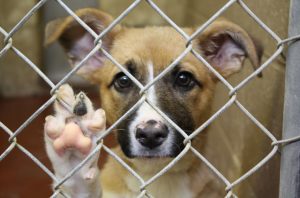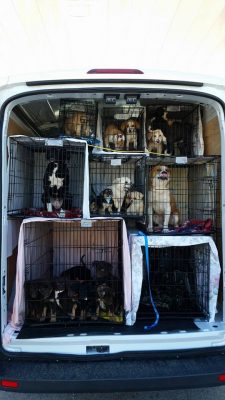

I have on occasion heard dog owners proudly state, “Oh, yes: we rescued this dog. She was going to die in a shelter.” Sometimes this statement is perfectly true: they went to a kill shelter, adopted a high-risk dog, and trained her: thus rescuing her. Many other times people adopt a dog from a canine rescue agency. In this case, the story is far more complex — and interesting. While the adopter may claim to have rescued the dog, that credit must be shared with many who played a part along the way.
Where Canine Rescue Begins
Canine rescue almost always begins with someone being a jerk. On the rare occasion, a dog loses his home because his owner dies suddenly or is hospitalized for a long time and has not made arrangements for the dog’s continued care — which is still sort of being a jerk. More often, dogs become homeless because their owners life style changes and the dog no longer fits in, so they are surrendered to a shelter — or abandoned to wander until Animal Control picks them up.
Many times that cute ball of fluff the people adopted and thought was adorable when it frolicked and jumped up on them for attention was not so adorable when she weighs 30 pounds and is knocking over the kids and chewing up the sofa. So because the people didn’t bother to train the dog, the dog gets dumped at a shelter as “unmanageable”.
Other times people have a number of dogs that they can’t care for properly. Sometimes these people are mentally ill or old. Sometimes these people are just cruel and uncaring. The dogs receive minimal care, little food, and no medical attention. I’ve seen dogs come in from situations where multiple dogs are penned up together, all living in their own feces, no clean water, what food they get is a bowlful of kibble or some table scraps tossed in for them to fight over.
I once worked at a shelter where 20+ dogs came in from a hoarding situation and some of those dogs had never been touched by a human hand. It started with a woman who could not get her two dogs to a low-cost clinic for spay/neutering. So they bred. She was ashamed to call the shelter for help. Then the puppies came of age and started inbreeding. It got weird from there. Animal control came to remove all the dogs. One had to be euthanized for being vicious. Some puppies died or were killed by the vicious one. The rest were rehabilitated and adopted or put into rescue programs. Some of them were not easy to rehab.
Canine Rehabilitation
Some owner surrenders are dogs who have been loved, cared for, and trained. These dogs are ready to move to a new home right away. Some owner surrenders, many stray dog situations, and most hoarding victims are dogs with little or no training or socialization. Some are terrified and defensive/aggressive. Socialization and training are a must before these dogs can be adopted to most homes. This is where shelter or rescue staff and foster homes come into play.
It takes time and patience to mold these hoodlum dogs into well behaved, loving companions. In many cases, these are not behavioral superstars but they are now calm enough to be teachable. Some rescues and most foster homes will housebreak the dogs as well.
Adoption Centers
Rescued dogs can be adopted from local animal shelters or from some canine rescue agencies. Not all rescues do local adoptions. To do this well requires enough staff (and most rescues are all volunteer run) to do home inspections, veterinarian interviews, and background checks. Smaller rescues focus on removing dogs from dangerous situations and rehabilitating them. They then work with bigger rescues and no-kill shelters to find the dogs new homes.
Rescue Transporters

The reality of canine life in the USA is that southern states have lax spay and neuter laws, thus a high population of unwanted animals. Northern and East Coast states have more stringent regulations, so there is actually a demand for good pets in those areas. To save lives, dogs are transported from areas of over-population to areas of need.
Many times the canine rescues (and even animal shelters) involved in the intake process will send van-loads of animals north and east to save lives. But there are also many programs and even individuals who make it their mission to run vans, semi-trucks, even aircraft to transport these animals between those who have too many and those who need. Here are some examples, if you’d care to read about them:
- The Dog Rescuer
- Volunteer Pilots Fly Shelter Dogs
- Pilots N Paws (Facebook)
- Wings of Rescue
- Truckers Love Dogs
Forever Homes

The objective is to find these animals loving, stable homes where they will be allowed to live out their lives with a caring family. Not all rescue stories end this way, but that is the hope of everyone involved.
The end goal for all of us, from the true rescuers who go out in the field to pull stray dogs out of storm drains to the families who want to give a trained and rehabilitated rescue dog a good home, is to get them that good home.

By the time a dog loads up into a family car for the ride home, it may well have passed through the hands of many people, and several locations. Not always: sometimes it’s all done locally by one shelter or rescue, but sometimes that dog’s story is one worthy of an epic movie!
| If you enjoy our updates, Doggy Tales, and educational articles consider subscribing for notices when new pieces are posted. It’s painless and you can unsubscribe any time you want. Your e-mail address is used ONLY to deliver these notices. | [email-subscribers namefield=”YES” desc=”” group=”Public”] |



